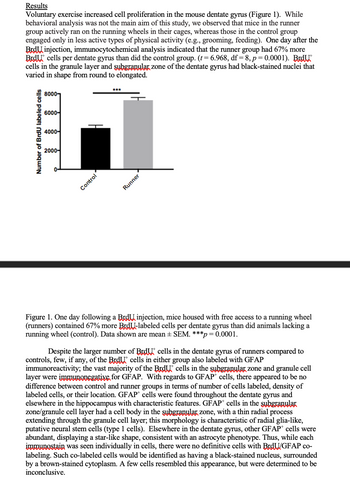
interpret these results and explain these as detailed as possible
include an explanation of why the results demonstrate what they do and possible explanations for this

Trending nowThis is a popular solution!
Step by stepSolved in 3 steps

could you explain a bit more what this sentences mean:
The information displayed demonstrates a significant increase in cell proliferation inside the dentate gyrus of mice that were locked in voluntary exercise compared to the control group. The use of 5-Bromo-2'-deoxyuridine (BrdU), a thymidine analog, permits the following of recently formed cells because it is incorporated into the DNA of dividing cells amid the S stage of the cell cycle. The immunocytochemical examination uncovered a 67% increase in BrdU-labeled cells within the running group, meaning upgraded neurogenesis, which is factually noteworthy as shown by the p-value of 0.0001.
The observation that the runner group effectively utilized the running wheels given in their cages relates to the increment in BrdU-labeled cells.
could you explain a bit more what this sentences mean:
The information displayed demonstrates a significant increase in cell proliferation inside the dentate gyrus of mice that were locked in voluntary exercise compared to the control group. The use of 5-Bromo-2'-deoxyuridine (BrdU), a thymidine analog, permits the following of recently formed cells because it is incorporated into the DNA of dividing cells amid the S stage of the cell cycle. The immunocytochemical examination uncovered a 67% increase in BrdU-labeled cells within the running group, meaning upgraded neurogenesis, which is factually noteworthy as shown by the p-value of 0.0001.
The observation that the runner group effectively utilized the running wheels given in their cages relates to the increment in BrdU-labeled cells.
- Differentiate the lock-and-key model from the induced fit hypothesisarrow_forwardDiscuss which are the elements of the protocol for implementing a questionnaire data collection method. Elaborate a strategy for questionnaire design addressing the research question: "Does COVID-19 affect the work satisfaction of employees?". Propose four main questions that are suitable in your view to be part of this questionnaire. Briefly motivate your choice of questions and the strategy for the question-design that you have used.arrow_forwardNon-specific interactions present a real challenge to co-IP experiments because non-physiological binding to the target complex is likely to occur. Group of answer choices True Falsearrow_forward
- TRUE or FALSE: I expect for genetically identical animals thta have been reared in similar conditions to have a similar SD for any paraeter that I decide to measure compared to genetically diverse animals that have been grown in a variety of natural environments.arrow_forwardwhat is a quasi experimental study and what are the benfits and limitationsarrow_forwardCompare the 95% confidence interval for the difference between two true means with the 95% confidence interval for an individual true kean. Describe one way in which these two equations are similar and state four ways in which these equations differ.arrow_forward
- Thinking Critically What is a limiting factor? Can you think of some examples not given in the text?arrow_forwardConsider the variables: A, B, C, D, E, F, G, and H. A and B, B and C, C and D are directly related while D and E, E and F, F and G, and G and H are inversely related. If an initial increase occurs in the value of A, the value of H will a. decrease b. increase c. stay the same d. cannot predict from the given informationarrow_forwardwork rate at VT2 was a stronger correlated of fatigue during repeated bouts (approximately 25 seconds when compare to work rate at VO2max in ice hockey players. Which of the following is not a potential rationale for the study’s findings?enhancing buffering capacity may improve PCr resynthesiswork rate at VT2 may better reflect buffering capacitywork rate at VT2 may be the sustainable work rake that athletes slow to during repeat boutall are correctarrow_forward
- Do the whole question. Please they are attached an image.arrow_forwardDetermination of phosphorus in blood serum gave results of 4.40, 4.44, 4.64, 4.47, and 4.49 ppm P. Determine whether the 4.64 ppm result is an outlier or should be retained at the 99% confidence level. Q = Qcrit= Decision: Reject/Retainarrow_forward
 Human Anatomy & Physiology (11th Edition)BiologyISBN:9780134580999Author:Elaine N. Marieb, Katja N. HoehnPublisher:PEARSON
Human Anatomy & Physiology (11th Edition)BiologyISBN:9780134580999Author:Elaine N. Marieb, Katja N. HoehnPublisher:PEARSON Biology 2eBiologyISBN:9781947172517Author:Matthew Douglas, Jung Choi, Mary Ann ClarkPublisher:OpenStax
Biology 2eBiologyISBN:9781947172517Author:Matthew Douglas, Jung Choi, Mary Ann ClarkPublisher:OpenStax Anatomy & PhysiologyBiologyISBN:9781259398629Author:McKinley, Michael P., O'loughlin, Valerie Dean, Bidle, Theresa StouterPublisher:Mcgraw Hill Education,
Anatomy & PhysiologyBiologyISBN:9781259398629Author:McKinley, Michael P., O'loughlin, Valerie Dean, Bidle, Theresa StouterPublisher:Mcgraw Hill Education, Molecular Biology of the Cell (Sixth Edition)BiologyISBN:9780815344322Author:Bruce Alberts, Alexander D. Johnson, Julian Lewis, David Morgan, Martin Raff, Keith Roberts, Peter WalterPublisher:W. W. Norton & Company
Molecular Biology of the Cell (Sixth Edition)BiologyISBN:9780815344322Author:Bruce Alberts, Alexander D. Johnson, Julian Lewis, David Morgan, Martin Raff, Keith Roberts, Peter WalterPublisher:W. W. Norton & Company Laboratory Manual For Human Anatomy & PhysiologyBiologyISBN:9781260159363Author:Martin, Terry R., Prentice-craver, CynthiaPublisher:McGraw-Hill Publishing Co.
Laboratory Manual For Human Anatomy & PhysiologyBiologyISBN:9781260159363Author:Martin, Terry R., Prentice-craver, CynthiaPublisher:McGraw-Hill Publishing Co. Inquiry Into Life (16th Edition)BiologyISBN:9781260231700Author:Sylvia S. Mader, Michael WindelspechtPublisher:McGraw Hill Education
Inquiry Into Life (16th Edition)BiologyISBN:9781260231700Author:Sylvia S. Mader, Michael WindelspechtPublisher:McGraw Hill Education





